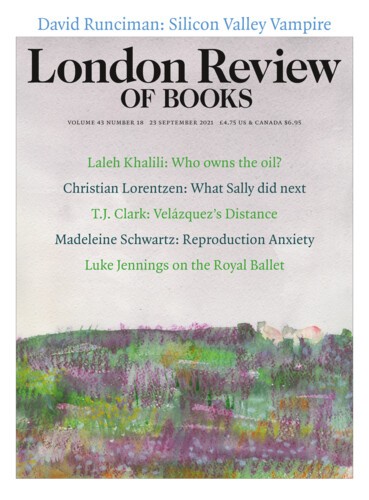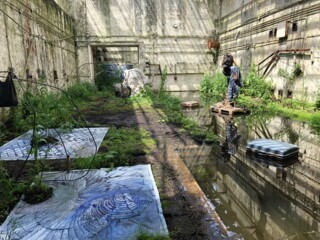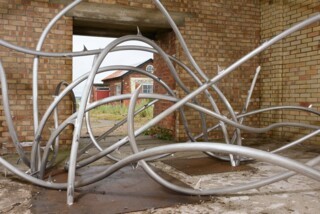Afterness, Artangel’s latest installation of new artworks in ‘unexpected places’, opened in June on Orford Ness, a weather-beaten spit of Suffolk shingle a few miles downcoast from Aldeburgh. For much of the 20th century, Orford Ness was the site of atomic and other weapons testing by the military. Now it is managed by the National Trust and can be accessed by boat from a quayside lined with tearooms. On a summer’s day it retains only a trace of the foreboding that was for so long part of Orford’s appeal. The National Trust has been soliciting tourism to the Ness for years, with W.G. Sebald as bait. ‘When I was first in Orford,’ he writes in The Rings of Saturn, ‘it was forbidden to approach “the island”, but now there was no obstacle to going there, since, some years before, the Ministry of Defence had abandoned secret research at the site.’ He pays a ferryman to take him across the River Alde and imagines himself arriving at ‘the remains of our own civilisation after its extinction in some future catastrophe’.
Tatiana Trouvé’s The Residents – which occupies a 1960s laboratory whose ceiling has collapsed, leaving only a skeleton of rusty scaffolding – takes up the Sebaldian theme of abandonment, or is inspired by a similar vision. She has created a mise-en-scène of mysterious artefacts, totems, remnants: a suitcase, discarded clothing, blankets etched with geological charts, metal gates inspired by the stick charts Marshall Islanders used to navigate currents in the Pacific. If this associative assortment is a little predictable, the ‘storyline’ a bit Waterworld, it is compensated for by Trouvé’s anticipation of the meteorological conditions of the Ness. Already waterlogged, and latticed on a fine day with interlocking grids of sun and shadow, Lab One has half-subsumed the installation, which began immediately to decompose on exposure to wind and water. The effect was convincing enough to fool the Guardian, which included a photograph of The Residents, identified only as a former research facility, in a travel piece about the East Anglian coast.
As these forgotten stretches have grown less eerie, less desolate, commissions such as those at Afterness have been forced to work harder. They also have to differentiate themselves from other attempts to capture the strangeness that remains. The poetic soundscape connecting the installations (you listen on headphones as you walk around) has echoes of Untrue Island, a libretto from 2012 written by Robert Macfarlane at the request of the National Trust. Here is Macfarlane:
Listen. Listen now. Listen again to the sounds of this slow-flowing shingle river. Listen to the voices of this untrue island. Listen to the Ness: it speaks gull, it speaks wave, it speaks rust, it speaks lichen. Hear the Ness: it speaks bullet, it speaks ruin, it speaks redshank, it speaks deception, it speaks pagoda, it speaks transmission, it speaks reception, it speaks pure mercury, it speaks fluent flint, it speaks utmost secret, it speaks swift current, it speaks broken signal, it speaks shifting shingle, it speaks precarious wisdom, it speaks rapid-fire.
And here is a section from I See a Silence, a series of poems by Ilya Kaminsky commissioned for Afterness and read by Kaminsky and two actors:
Ness exhausts
with skylarks, boat motors, gulls, gravel, with the embarrassed silence of an empty stairwell in the ballistics building, with goosesteps, knowing that silence of the living is visible at Ness, in your lungs and in mine, in a single bee’s drone.
There are echoes of the echoes. The sound design by Axel Kacoutié and the occasional lapses of the readers into ‘poetry voice’ recall The Borough, a ‘theatrical journey’ through Peter Grimes staged at the Aldeburgh Festival in 2013. It, too, was experienced through headphones that weren’t quite noise-cancelling, so that the recorded sounds – waves, gulls, footsteps on shingle – merged and swapped places with the same sounds in real life, an uncanny form of site-specific immersion. I See a Silence goes further than its predecessors, however, in stretching the elastic between text and site, even as well-judged timings anchor it in the overall schema. ‘Look up at the windows,’ a voice urges us, just as the tower known as Black Beacon appears above a shingle ridge. ‘They are like heads bandaged for toothache.’
Kaminsky is hard of hearing, and was almost completely deaf for most of his childhood. I See a Silence turns on a paradoxical longing: ‘All I ask is/a moment of quiet,’ he says in the opening poem. ‘I a deaf man want some quiet I want some quiet.’ Silence, ‘the invention of the hearing’ as Kaminsky puts it, is a quality we ascribe to remote places like the Ness, when what we really mean is that we no longer hear other humans. ‘Silence is inside all sound; you and I are permitted/to listen to silence, which reveals ourselves to ourselves,’ one voice says, then the recording goes quiet for a while, and our footsteps sound suddenly louder. ‘How my feet hammer the tightened drumskin of this quiet!’ another concludes. But this aural exploration of the site is also entirely imaginary: the pandemic meant Kaminsky was unable to leave his home in Atlanta and the poems are ‘a record of trying to go there’ with his mind’s ear – perhaps in the manner that only ‘a deaf man’ can. This accident of commissioning has a cost (some of the descriptions are generic, or just plain wrong), but the compensation is a sustained effort of imaginative translation that transcends, or bypasses, its over-familiar origins.
By comparison, the field recordings by Iain Chambers, Chris Watson and Brian d’Souza are one-dimensional. They can be heard at Black Beacon, which was erected in the 1920s to develop radio systems for marine navigation. Here found sounds play out in splendid isolation, the world from which they have been extracted barely audible through the building’s narrow window slits. The index is itself a kind of poem – ‘025: Control Room: closing door; interior; human whistle; pebbles’ – and finds its way into Kacoutié’s composition and Kaminsky’s writing: ‘029: Drone of a single bee’. Similarly obsessive but much wittier is Emma McNally’s The River that Flows Nowhere, Like a Sea, a gigantic pencil-drawn chart of unlabelled infographics and interconnections, concentric circles, seething sub and super-strata, suggestive of geology and topography and the tides, scrunched up in the old armoury like a chrysalis about to hatch. Visitors are offered torches with which to explore the detail in the dark, and the tableau of half-illuminated pantomime potholers is one of the show’s unexpected achievements.
Kaminsky’s text suggests other connections between the five main commissions: exposure, quarantine, refuge, Sebald’s history of violence. Kaminsky was born in Odessa in 1977 and was living only a few hundred miles south of Pripyat when the No. 4 reactor at Chernobyl exploded. There is jeopardy and near nuclear history on the Ness, ‘this atomic site’, but also something else. As Cal Flyn writes of the Chernobyl Exclusion Zone in Islands of Abandonment: Life in the Post-Human Landscape (William Collins, £16.99):
These radioactive hinterlands are the consequences of human folly, hubris, of deals made with the devil. That they have been badly contaminated is evident, but it has also been growing increasingly clear that the Dead Zone is not dead at all … after a few seasons, the regrowth began in earnest. Animals reappeared: lynx, boar, deer, elk, beavers, eagle owls – and on, and on … A decade later, every animal population in the zone had at least doubled in number. By 2010, the wolves had increased sevenfold. In 2014, brown bears were spotted in Chernobyl for the first time in a century. The apparently remarkable recovery of the environment around the reactor … could be considered a provocative thought-experiment made real.
Orford Ness is the largest vegetated shingle spit in Europe, a nature reserve of international significance. The managed decline of the buildings, the tours and the tea shops and the art, are all a side hustle for the National Trust, with the real work of conservation undertaken out of sight, although not entirely out of hearing. The field recordings multiply the plants and creatures around Black Beacon. Kaminsky inserts black-tailed godwits and ‘Sea Pea and Sea Kale and/Sea Campion and Prickly Sow-Thistle’, and rabbits where there should be hares. Trouvé re-rewilds Lab One, introducing a new layer of human activity for nature to flood and consume. McNally maps the patterns of ‘unnamed flowing’ (Wallace Stevens’s phrase – she borrowed her title from his ‘River of Rivers in Connecticut’) within which the Anthropocene is the exception, rather than the rule. Alice Channer’s Lethality and Vulnerability, the fifth work at Afterness, is a Lovecraftian aluminium bramble which seems to be smashing its way out of an old shack known as ‘the shelter’. These experiments in rewilding will remain in place until the end of October, and may return next year, weathering in harmony with the buildings they occupy.
Send Letters To:
The Editor
London Review of Books,
28 Little Russell Street
London, WC1A 2HN
letters@lrb.co.uk
Please include name, address, and a telephone number.



